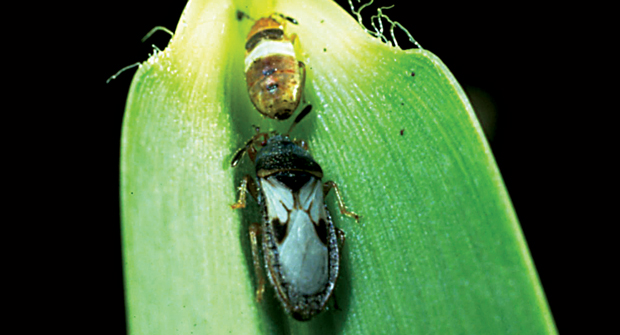Chinch bugs are an elusive turf pest that can be a major problem for a lawn care operator (LCO) and their customers.
To ensure this turf killer doesn’t harm your lawn, Steve McDonald, chief plot sprayer and owner of Turfgrass Disease Solutions — a Pennsylvania-based consulting company — says LCOs must stay vigilant and know the signs that mean chinch bugs are present.
“I’ve seen it damage fescues and bentgrass. I’ve seen it on some zoysiagrass as well as ryegrass,” he says. “Once it gets into a stand, it can do a lot of damage pretty quickly.”
Made in the shade
McDonald tells LM that chinch bugs prefer open, dry areas. If LCOs work on a lawn with areas shaded by trees, they may see populations stop at the shade line. Chinch bug damage can frequently be mistaken for drought damage, making identification crucial.
“The turf will turn to a straw or light brown color. it looks droughty,” he says. “People will mistake it for drought stress, and they’ll add water to it and it doesn’t get better. Within seven to 10 days, the soil moisture is adequate and then that’s when you typically start some investigation.”
To identify a chinch bug infestation, McDonald recommends getting down in the weeds and pulling back turf.
“Pull the grass back with your hands and look at the soil surface where it meets the turf,” he says. “If you have hairy chinch bugs, you’ll see small insects with what looks like a white ‘X’ on their backs, scurrying around. You won’t see one, you’ll see hundreds of them.”
There are several methods — in addition to pulling turf — that LCOs can use to ID a chinch bug problem. McDonald says if you’re in a rush a quick way to find out if you have chinch bugs is by using soapy water on turf to float bugs to the surface while looking for the familiar white X on the insect’s back.
Several types of chinch bugs affect turf in the U.S., but the most common, McDonald says, are hairy chinch bugs.
Time to apply
When applying for chinch bug control, McDonald recommends a mid-to-late June application. Chinch bug damage will typically appear in early July, so the June application — which can coincide with white grub applications — will take hold before chinch bug populations build up.
In terms of active ingredients, LCOs can look for chlorantraniliprole, clothianidin or acephate. McDonald says products like Acelepryn Xtra from Syngenta fit the bill for the base of a good chinch bug control program.
“We had low rates of Acelepryn Xtra, but we saw phenomenal control of hairy chinch bugs for 45 to 60 days following the application in the summer, even at those low rates,” he says. “In our research, it’s been successful as a broad-spectrum insecticide on a range of turfgrass pests, from chinch bugs to cutworms to grubs, it’s performed very consistently.”
McDonald adds that LCOs shouldn’t assume that their chinch bug problem will be a one-season issue. To fully ensure that chinch bugs will be kept at bay, it can take several seasons of applications and implementation of cultural practices.
“(You might) make an application and it decreases the pressure the next year substantially,” he says. “But it’s still important to remember that these insects have a pretty high population. So even if you get control of 90 or 95 percent, you could potentially have some issues the following year, especially if the situation with watering and the temperatures are the same.”


